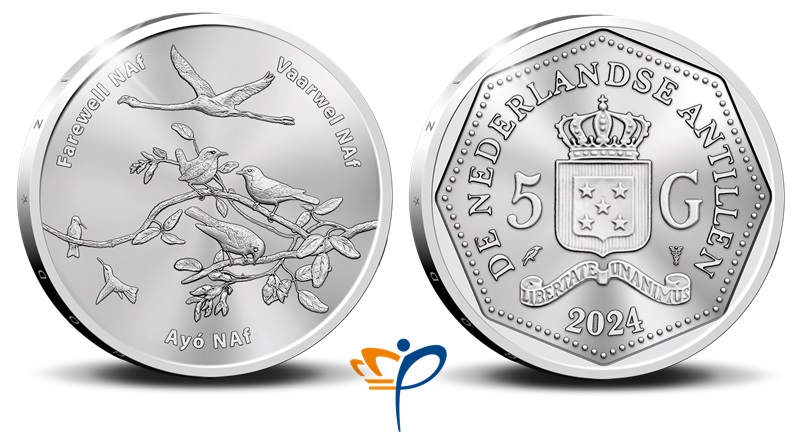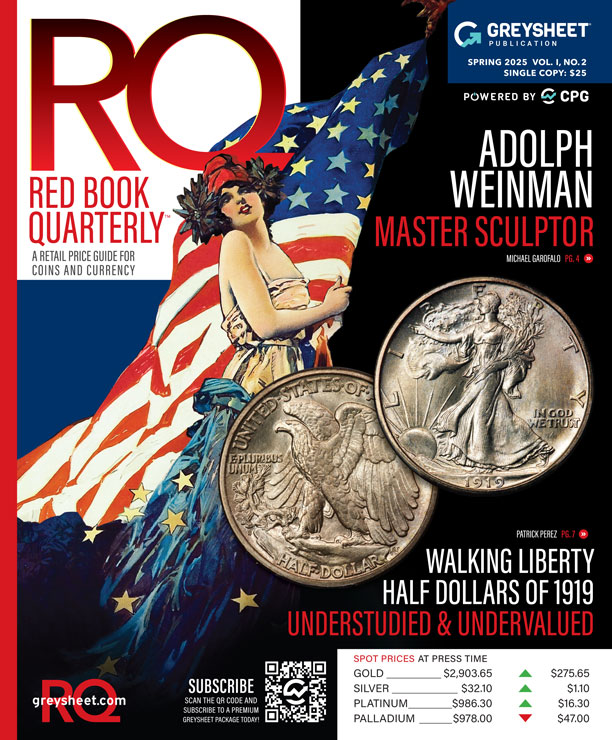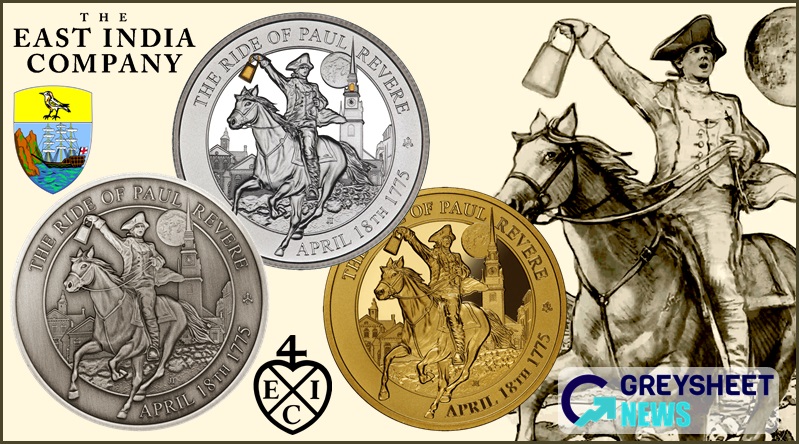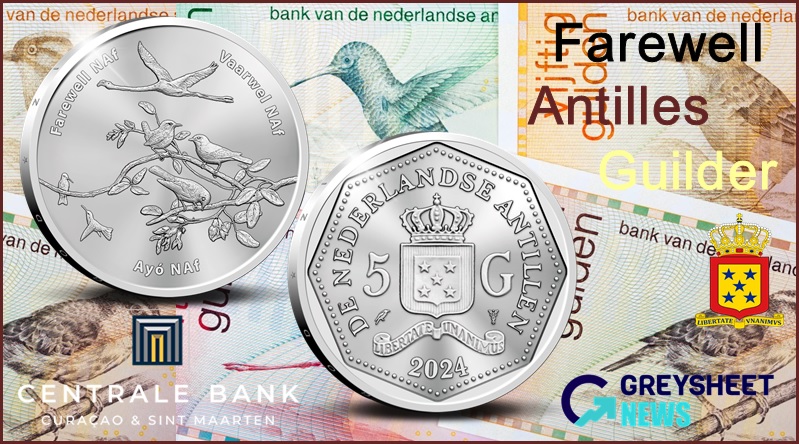Curacao & St. Maarten: Last Silver Coins Bid Farewell To The Antilles Guilder And Welcomes The Caribbean Guilder
The Central Bank of Curacao and St Maarten release new silver proof coins in tribute to the soon to be discontinued Antilles Guilder.
With the change in political representation of the Dutch Antilles overseas territories in 2010, a change both in name and currency were announced soon thereafter. The name of the Central Bank of the Netherland Antilles was changed in 2010 to the Central Bank of Curaçao and Sint Maarten. As such, these coins will be the last to carry the name NEDERLANDSE ANTILLEN on the reverse. Since the bank can trace its establishment to 1828, it is the oldest surviving central bank in the Americas. The Dutch Caribbean colonies of Aruba, Bonaire, Curacao, St. Eustatius, St Maarten and Saba were important links to the Dutch crown in terms of lucrative trade between the Americas and the homeland. However, due to the many entities who traded in the Antilles, it meant that many currencies were prevalent in the islands which contributed to a shortage of coin, speculation, and ineffective currency exchange. The Curaçao Reaal was the de-facto currency of the Dutch Antilles from 1799 with 12 reaal equal to one Spanish dollar of 8 reales, later changed to 15 reaal in 1815.
It was on the initiative of Dutch King Willem I who saw great potential in expanded trade with the Antilles and envisaged Curaçao in particular as the centre for all trade between the Dutch Kingdom and America. As such, in 1826 the King proposed the establishment of a bank connected to direct crown rule to organise the Colony's financial affairs. Two years later, on the 6th February 1828, the entity which later became known as the Curaçaosche Bank was established. Housed in the Garrison Fort of the West Indian Company, now known as Fort Amsterdam, it was an ideal location as this is where the government administration also was located. Three clerks, employees in the General Accounting Department, were appointed for the administration and accounting of the newly established bank. Thus, the Bank became part of the Financial Department as a state bank though it did not have an official issuance status. Consequently, The Reaal was ultimately replaced that same year by the homeland Dutch Guilder which traded at a rate of 3.33 for one guilder. It would not be for another sixty four years that guilder banknotes specifically issued for exclusive use in the Netherland Antilles included the name of Curaçao. Silver coins followed in 1900 with the production of tenth and quarter guilder denominations and their issuance as KOLONIE CURACAO shown on the reverse. Both currencies were equal in value until the beginning of the Second World War. With the invasion by forces of the Third Reich of the Netherlands in 1940, the link between the currencies was broken. The Antilles Guilder was thereafter linked to the US Dollar and during the fighting, guilder coins denoting CURACAO on the reverse side and banknotes were produced in the United States. By 1952, a new series of circulation coinage was produced with their issuance depicted as NEDERLANDSE ANTILLEN on the reverse and the definitive effigy of the Dutch monarch shown on the obverse. Banknotes issued by the Centrale Bank van de Nederlandse Antillen were thereafter issued from the 1st January 1962.
With the separation of Aruba from the rest of the Netherlands Antilles in 1986, the formation of the Centrale Bank van Aruba and issuance of Aruban florins replaced the Antilles Guilder at an equal exchange rate. The last significant change to the Antilles occurred when the geo-political entity was formally dissolved in October 2010. The islands of Bonaire, St Eustatius and Saba adopted the US Dollar as legal tender in 2010 while Curacao and St. Maarten have agreed to establish the Caribbean Guilder which is scheduled for release in March 2025. At which time, the Caribbean guilder will be legally pegged to the U.S. dollar at an exchange rate of US$1 = 1.79 Caribbean guilder. The exchange rate between the Netherlands Antillean guilder and the Caribbean guilder will be exchangeable at an equal rate. The denotation for the Caribbean Guilder has been assigned as Cg and in terms of ISO international standardisation, the code XCG has been assigned to the new currency. When physical Caribbean Guilder coins and banknotes are released, they will be in denominations of 5 guilders, 1 guilder, 50 cents, 25 cents, 10 cents, 5 cents and 1 cent. For banknotes, the denominations will be 10, 20, 50, 100 and 200 guilders.

The silver proof coins are produced by the Royal Dutch Mint at their facilities in Houten, Netherlands on behalf of the Centrale Bank van Curacao and St Maarten and designed by Nazanin Sholeh. The obverse side depicts a collection of six different types of birds native to the six islands of the Dutch Caribbean and were featured on the last series of Netherland Antillean Guilder coins and banknotes. Towards the left, right and lower rim is the text denoting the end of the Antillean Guilder – Naf and is shown in English - Farewell NAf, in Dutch - Vaarwel NAf and in Papiamento / creole - Avó NAf. The reverse side depicts for the last time, the official crowned crest of the Netherlands Antilles, which includes five stars on the shield representing the remaining five islands after the separation of Aruba in 1986. To the left of the shield is the numeral 5 and to the right is the letter G referencing the denomination of five Guilders. Below the crest is the year 2024. Each coin includes the incused edge lettering *GOD*ZIJ*MET*ONS.
| Denomination | Metal | Weight | Diameter | Quality | Maximum Mintage |
| 5 Guilders | .925 Silver | 11.9 g. | 29 mm. | Proof | 1,000 |
Each proof quality coin is encapsulated and presented in a custom case accompanied with a numbered certificate of authenticity. For additional information, please visit the e-webshop of the Royal Dutch Mint.
From the 1st July, a two-nation-wide preview will be launched by the Centrale Bank van Curacao en Sint Maarten which marks the start of a month-long project towards familiarisation. The awareness campaign will run through to the 22nd August 2024, when the designs of the Caribbean guilder banknotes and coins will be revealed simultaneously in Curaçao and Sint Maarten. Following the unveiling of the designs of new banknotes and coins, an information campaign will be launched to introduce the new currency to the public. The awareness campaigns are well in advance as the Centrale Bank anticipates the Caribbean guilder entering circulation on the 31st March 2025.

Download the Greysheet app for access to pricing, news, events and your subscriptions.
Subscribe Now.

Subscribe to RQ Red Book Quarterly for the industry's most respected pricing and to read more articles just like this.
Author: Michael Alexander
Related Stories (powered by Greysheet News)
View all news
The Central Bank of Samoa release new Baseball-themed silver coins celebrating America's pastime.

The Treasury of St Helena / The East India Company release new coins marking an historic American anniversary.

Munze Deutschland release the fourth coin in their polymer ring collector coin series focusing of public service.









Please sign in or register to leave a comment.
Your identity will be restricted to first name/last initial, or a user ID you create.
Comment
Comments